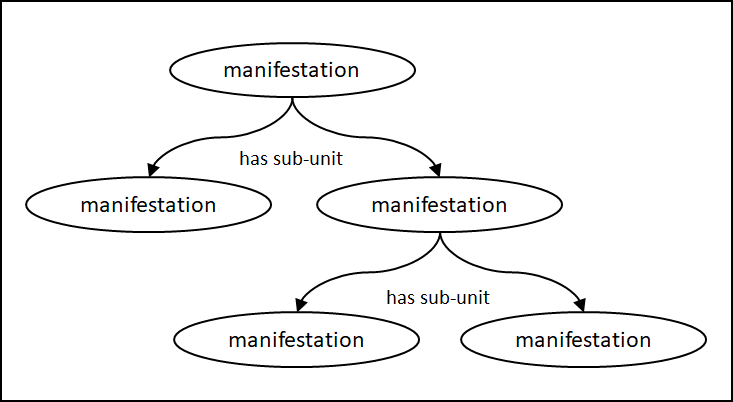Number of units
A manifestation may be published or produced in one or more logical or physical parts.
A manifestation inherits the conceptual parts of a work by embodying expressions of the parts. There is no intrinsic relationship between the conceptual parts and the logical or physical parts.
A logical or physical part is termed a "unit" for clarity. A unit is a logical part of an intangible manifestation or a physical part of a tangible manifestation.
Assess the number and hierarchical structure of units of the manifestation.
Consider a manifestation that is an "online resource" to have more than one logical part if distinct content has its own Uniform Resource Locator (URL) that is based on the root URL of the manifestation. Consider the manifestation to have only one logical part if all content has the root URL.
For a manifestation that is two or more unattached sheets, consider each sheet to be a part of the manifestation irrespective of the layout of the content that is embodied in the sheets.
Consider a manifestation that embodies an issue of a successive diachronic work to be a sub-unit of the manifestation that embodies the incomplete diachronic work. The number of sub-units of the manifestation increases over time.
Consider a manifestation that embodies an iteration of an integrating diachronic work to be the manifestation that embodies the incomplete diachronic work. The number of sub-units of the manifestation may increase or decrease over time.
A manifestation may have no more than one super-unit that embodies a static work.
A manifestation may have more than one super-unit that embodies a diachronic work.
The structure of a multiple unit manifestation may form a hierarchy of super-units and sub-units.

The diagram shows a model of the hierarchy of units in a multiple unit manifestation. A manifestation that has physical or logical parts is a super-unit, and a manifestation that is a physical or logical part is a sub-unit. A unit may have more than one direct sub-unit and a super-unit. A unit is related to a sub-unit with a has sub-unit element and to a super-unit with an inverse has super-unit element.
Record a value of has unitary structure to indicate that the manifestation is published or produced in one or more units